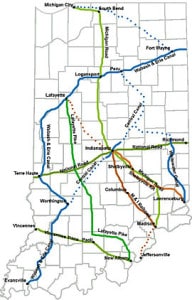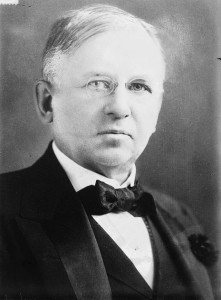
It is always a challenge, when recounting the history of an area, to know where to begin. There are long stretches of our land’s past of which we have little or no historic record, including the hundreds of years that Native Americans inhabited this area prior to the arrival of European settlers.
But we must start somewhere. Indiana became a state in 1816, a date which roughly corresponds to much of our extant historic record, so that seems as good a point as any to begin the history of present-day Franklin Township.
Part 1: New Bethel & Wanamaker
The Michigan Road – a portion of which is now Southeastern Avenue – was one of the most important transportation routes in the early history of Indiana. The Michigan Road connected Madison (on the Ohio River) to Michigan City (on Lake Michigan), and ran through the new state capital of Indianapolis on the way. The road was officially commissioned in 1826, but Barry Sulgrove’s History of Indianapolis says that the route had cut through a good portion of this region as early as 1820, and it was via this that many pioneers came to Marion County.
The History of Indianapolis also states that it was believed that the first permanent settler within the present boundaries of Franklin Township was William Rector, who came here from Ohio in 1820 and built his cabin on lands bordering Buck Creek.
In 1825, a man named Reuben Adams moved to from Kentucky to Indiana. He cleared land, built a cabin and then moved his family to the area, but died the following year. Reuben’s widow, Mary Adams (after whom the local elementary school is named) raised their eleven children alone.
In 1827, the Adams family donated a parcel of land along the Michigan Road for the construction of the New Bethel Baptist Church (presently located at 8936 Southeastern Avenue). Today, in the cemetery directly across the street from that church, you can visit the graves of Reuben and Mary Adams, buried on what had once been part of the land that Reuben settled.
In March of 1834, Mary Adams hired a planner named John Messinger to lay out the town of New Bethel on a portion of her farmland. The town’s name, New Bethel, was taken from the New Bethel Baptist Church, which by this time had existed for about seven years.
Some years later, when the town of New Bethel sought to have a post office, it was found that there was already a town with that name elsewhere in Indiana, and residents were told that the town would have to be renamed. The name Wanamaker was chosen to honor John Wanamaker, President Benjamin Harrison’s postmaster general. Wanamaker was a successful and highly-respected Philadelphia businessman who established one of the first department stores in the United States, and had expanded the chain of stores to New York, London and Paris.
New Bethel was officially renamed Wanamaker during the late 1800s — but old habits die hard, and debate about the name continued for many decades, as road signs and residents used both names. To this day, remnants of the original name can be found throughout the town, such as the New Bethel Ordinary (the well-known restaurant and pub in Wanamaker, whose present sign has been abbreviated to “NBO”) and several housing additions that include “New Bethel” in their names.
To be continued in part 2…



Just wanted to make sure that it’s ok to use this information for promotional purposes. I’m putting together media that highlights the area and this story is interesting to me. I emailed the address given, so if it’s not alright to use, please let me know.